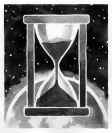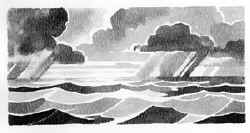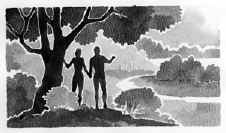The Torah: Genesis 1: Are the Six Days of Creation Literal or Figurative?
The first chapter of the Bible says that God made heaven and earth and every living thing in six days. Are those six “days” to be understood literally, as six 24-hour days, or are they symbolic — figures of speech? Bible-believing Christians disagree on this topic, often with great emotion, sometimes condemning all who do not understand Genesis 1 in the same way as they do.
 The literal view is simple: Genesis 1 is telling us that God created everything in six evenings and six mornings — ordinary-length days. The literal view says, Believe it because that is what is written.
The literal view is simple: Genesis 1 is telling us that God created everything in six evenings and six mornings — ordinary-length days. The literal view says, Believe it because that is what is written.
But is that really what is written? Let us look at the evidence in Scripture. We can start with day four as an example: On the fourth day, God commanded that there be lights in the sky to separate day and night. He made the sun, moon and stars to separate light from darkness (Gen. 1:14-18). But we are told in verse 4 that God had separated light from darkness on the first day; and the words “evening and morning” show that there was already a separation between night and day. So what really happened on the fourth day of creation?
 One conservative suggestion observes that the Hebrew word for “made” could mean “had made” — God may have made the sun, moon and stars billions of years earlier, and God caused them to be visible on the fourth day of creation. The creation account is written from an earthly perspective. Since half of earth is in darkness when the other side is in day, the terms evening and morning indicate a perspective not only limited to earth in general, but to a specific point on earth.
One conservative suggestion observes that the Hebrew word for “made” could mean “had made” — God may have made the sun, moon and stars billions of years earlier, and God caused them to be visible on the fourth day of creation. The creation account is written from an earthly perspective. Since half of earth is in darkness when the other side is in day, the terms evening and morning indicate a perspective not only limited to earth in general, but to a specific point on earth.
However, if we say that the account is written from a limited perspective, we admit that the account is not abstract truth. When God called for light, he meant light at a specific point on earth, not light in general, because light already existed in outer space. When verse 14 says, Let there be sun and moon, it really means, Let earth’s surface have a clear view of the sun and moon, or perhaps, Let the sky be clear.
However, when we understand the Bible this way, we are not interpreting it literally. Perhaps the creation story was not meant to be interpreted literally.
Not designed for scientific accuracy
Genesis 1 does not describe how God created. It does not give us the physics of how he separated light and darkness, land and sea; it is not designed to tell us whether he created aquatic insects and land-dwelling insects on the same day. It does not tell us whether the stars existed before verse 16, or whether they simply became visible.
God began the creation by calling for light, and there is no other way for light to appear than instantly. Either it exists or it doesn’t. Therefore we might conclude that creation would have begun with morning. But what did God do in the afternoon? Did he continue to create more light, or did he rest? Did he rest in the evening, like he did on the seventh day? Even an ancient Israelite could have wondered. However, such questions try to squeeze precision out of an account that wasn’t designed for it.
God separated light from darkness (verse 4). The literary sequence implies that darkness was separated only some time after light existed, but light is always separated from darkness; they are distinct by definition. Perhaps verse 4 is not intended to be sequentially precise. Or perhaps it means that, at the assumed point of observation, darkness finally came. Either way, this is not what the text says literally.
Day 2 and 3
In verse 6 (day 2) God separated the waters. Where did this water come from? Genesis does not tell us. Verse 10 tells us that “earth” (same Hebrew word as in verse 1) is dry land; verse 8 tells us that space between waters is “heaven” (same Hebrew word as in verse 1). But it does not tell us when water was created, or how much water is above heaven. It is mentioned in verse 2 as simply existing. So here we see something else incomplete about the sequence.
 On day 3, God separated land and water (verse 9). We might imagine continents rising out of the ocean, but consider the hydrological problem that would exist if an entire continent rose in one 24-hour day. The Nile River is more than 4,000 miles long. Water would have to flow more than 150 miles an hour in order for Africa to appear in one day. Erosion would have been catastrophic unless God miraculously removed the water, or unless much smaller units of land were involved. The account gives a general picture, not a geological and hydrological description.
On day 3, God separated land and water (verse 9). We might imagine continents rising out of the ocean, but consider the hydrological problem that would exist if an entire continent rose in one 24-hour day. The Nile River is more than 4,000 miles long. Water would have to flow more than 150 miles an hour in order for Africa to appear in one day. Erosion would have been catastrophic unless God miraculously removed the water, or unless much smaller units of land were involved. The account gives a general picture, not a geological and hydrological description.
Also on the third day, land produced plants with seeds and fruits. Perhaps fully grown trees with mature fruits were created instantly—nothing is impossible for God — but perhaps this isn’t supposed to be read so literally. Perhaps all it means is that God created fruit-bearing trees — trees capable of bearing fruit.
A third viewSome scholars believe that Genesis 1 presents 24-hour days. Others believe that the account is figurative not only in the length of days but also the sequence of events. Some scholars take a “middle” view — that the sequence is correct, but the days are longer than 24 hours. Gerald Schroeder, for example, argues that Genesis presents creation in terms of “cosmic time,” in which time is relative to the expansion of the universe after the big bang. In this way he argues that creation day one was 24 hours long by the cosmic clock, but eight billion years long as we count time today. Day 2 would have been four billion years, and day three only two billion years. Day 6 would have been only 250 million years long. This mathematical solution, however, does not solve the sequential problems that are in Genesis 1. Other scholars, such as Karl Barth, say that the days of Genesis 1 are 24-hour days but deny that the chapter gives a literal picture of the actual creation. |
Day 4 revisited
On the fourth day, God called for the sun and moon to separate day and night — something seemingly unnecessary, for day and night already existed. And God commanded that the sun and moon “give light on the earth” — another thing that had already been done on day one. Part of the stated purpose is puzzling if we interpret the account literally — and these questions about sequence exist no matter how long the “days” were.
“God made two great lights,” we are told in verse 16. Since Hebrew does not have a past perfect tense, this phrase could mean that God had, at some unspecified time before, made the sun and moon. This grammatical solution works in English, but it wouldn’t impress the original Hebrew readers, who would simply see a series of similar verb forms: He did this, he did that, he did the next thing, etc. What a word could mean in English is not what it means literally. Literally, the verb tense is not specific, and if we try to be more specific, we are not interpreting literally. When we discuss past perfect tenses and unspecified prior times, we are implying that this list of God’s creative activities cannot be taken at face value as a chronological sequence. We are attempting to clarify something that was not intended to be precise.
One more observation about day 4: The sun, moon and stars were set “in the expanse of the sky” (verses 14, 15 and 17). Verses 6 to 8 inform us that the expanse of the sky was formed by separating water under the expanse from water above the expanse. We are told three times not just that the stars are visible in the sky, but that they are in the expanse. Genesis 1, if taken literally, describes a layer of water above the stars. However, there is no scientific evidence for a layer of water above the stars, nor can we imagine how there might be. Yet this is what Genesis 1 says if we take it literally. This again shows that the passage is not a scientific description, and the text itself forces us to allow figurative interpretations.
A very long day 6
On day 6, God created animals, and then humans, both male and female (verses 26-27). However, chapter 2 gives us a longer story. “When the Lord God made the earth and the heavens — and no shrub of the field had yet appeared on the earth…. God formed the man from the dust of the ground” (Genesis 2:4-7). Could it be that God created Adam before the shrubs? Either this sequence is wrong, or the sequence in Genesis 1 is wrong. Or could it be that neither story is meant to be sequentially precise?
After creating all animals and creating Adam, “God planted a garden in … Eden” (Genesis 2:8). And he “made all kind of trees grow out of the ground” (verse 9). The word planted (rather than “created”) implies time. Grow normally implies time, too — a long time, for trees.
God told Adam what he should do and what he could eat (verses 15-17). God then had him give names to “all the beasts of the field and all the birds of the air” (verse 19). This taxonomic job must have taken a lot of time, for if the names were to be meaningful, they would have to describe something about the animal, which means that Adam would have had to observe the animal and think about each one.
 Then God created Eve (verses 21-22). Adam named her, and expressed delight at his new companion (verse 23). His delight implies that he was aware of being lonely, which also implies passage of time.
Then God created Eve (verses 21-22). Adam named her, and expressed delight at his new companion (verse 23). His delight implies that he was aware of being lonely, which also implies passage of time.
Did all this happen in one 24-hour day? Ancient readers, if they thought about it, might conclude that creation was not as simple as Genesis 1 presents it. Perhaps Eve wasn’t really created on the same day as Adam, or perhaps Genesis 1 isn’t supposed to be a newspaper report. Perhaps it has a different purpose, and if we use it for chronology, we are misusing it.
“Day” — a span of time
We see a hint of that in a word-for-word literal translation of Genesis 2:4, which uses “day” in a nonliteral way: “in the day that the Lord God made earth and heaven” (New American Standard). This implies that God created everything in one day. (The NIV leaves yom untranslated in this verse, but it’s the same Hebrew word used in chapter 1 for “day.”)
Day has a broad range of meaning, and can be used in a general sense to mean a span of time. Genesis 2:4a, just like 1:1, uses the word bara’, “created.” Are 1:1 and 2:4a referring to the same time period? Is that time different than the verses between them? Does the literal meaning involve great jumps in time? This again suggests that the chapter is not intended to be an exact chronology. We cannot insist on precision if we are faithful to an account that was not meant to be precise.
But doesn’t Exodus 20 clearly tell us that God created everything in six days, and because of that the Israelites should work six days and rest the seventh? Yes, but the analogy works no matter how long the “days” of creation were, or even if they were of different lengths. The analogy applies to years, too, because Israelites were told to keep an agricultural sabbath every seven years. The analogy does not depend on chronological precision. God structured the Israelite work week, but we cannot assume that his creative week was the same length as one of ours. His perspective on time is different.
Many conservative commentators believe that the Bible should be read literally unless demonstrated otherwise. Many of them have been convinced on literary and theological grounds that Genesis 1 should probably be read otherwise.
One such commentator is Gleason L. Archer Jr., who writes: “Belief in the inerrancy of Scripture involves neither a literal nor a figurative rule of interpretation. What it does require is a belief in whatever the biblical author (human and divine) actually meant by the words he used” (Encyclopedia of Bible Difficulties, Zondervan, 1982, page 59).
We have seen that the creation account cannot be interpreted literally all the way through. God did not actually create the sun and moon on the fourth day. Nor were the creative acts of the fourth day for the purpose of separating night from day or giving light on earth. At least some of the account is poetic (for lack of a better term) rather than precise.
In how many aspects is the account nonliteral? Opinions vary. If some parts of the account are not meant literally, what about the days? Has the account been designed to form a symbolic pattern? Some parts of the account don’t fit literally, since creation began with light, not with evening. Other events, such as the separation of land from water and the growth of plants, also suggest spans of time longer than 24 hours. And even if the “days” are longer than 24 hours, the sequential questions still suggest that the chapter is not meant to be a chronological report.
Archer comments, “Genesis 1 was never intended to teach that the sixth creative day, when Adam and Eve were both created, lasted a mere twenty-four hours.” He says it is unlikely that “Adam’s experiences in Genesis 2:15-22 could have been crowded into the last hour or two of a literal twenty-four-hour day.”
Theological purposes
Genesis 1 does not give scientific facts. What then is it for? Primarily, it reveals God as Creator. The things that other people worshiped are not gods. Rather, they were created by the true God, who rules over the chaos “god,” who has power to command the ocean “god.” God is above the powers of nature; he is supernatural. Each day of creation dismisses more deities — light and darkness, earth and sky, land and water, sun and moon and stars, fish and birds, animals and even man. They are all created, having no power except that appointed by the Creator God. Archer writes:
“The purpose of Genesis 1 is not to tell how fast God performed His work of creation (though, of course, some of His acts, such as the creation of light on the first day, must have been instantaneous). Rather, its true purpose was to reveal that the Lord God who had revealed Himself to the Hebrew race and entered into personal covenant relationship with them was indeed the only true God, the Creator of all things that are.”
It is also possible that some of the described events, especially those in day 4 (which we have already admitted) and in 2:4-7, are out of their original order. This is also within biblical literary style. Bruce K. Waltke writes:
“As so often happens in Scripture, historical events have been dischronologized and reconstructed for theological reasons. For example, the nations listed in Genesis 10 came into existence after the confusion of languages at Babylon recounted in Genesis 11, but the writer has dischronologized events in order to put the nations under Noah’s blessing, not under the Babylon’s curse. According to Genesis 35:16-18, Benjamin was born in Canaan, but less than 10 verses later it lists Benjamin among Jacob’s sons born in Paddan-Aram, presumably to represent the youngest patriarch as taking part in the return of all Israel from the exile in Paddan-Aram. Biblical writers display a freedom in representing historical events for theological reasons.” (“The Literary Genre of Genesis, Chapter One,” Crux, December 1991, volume 27, number 4, page 7).
Days grouped in a pattern
There is also a schematic arrangement. In the first group of three days, God organized motionless spaces by separating one from another; in the second group of three days, God formed things to fill and “rule” over those spaces. The sun and moon and stars occupy and govern the light and darkness; the fish and birds fill and rule the water and air; the animals fill the land, and humans rule all.
Another theological reason for the six days of creation is the Sabbath. A one-day creation could demonstrate God’s power over all other powers, but we are given a pattern of six days and a day of rest. The Sabbath commemorates God as Creator, as having all power. It does not matter whether creation was actually done in six days. What matters is that the week is assigned to correspond to creation. Using that pattern, God told the Israelites to take a break from their occupations on the Sabbath, a break from their concerns with created things, so they can remember the Creator. This is one of the ritual laws that became obsolete when Christ died.
Faith and facts
None of the interpretations of Genesis 1 has explained everything. But it is clear that we cannot require a strictly literal reading. The difficulties involved in literalism show that the account is not intended strictly literally. It is right to allow exploration and to suggest some possible nonliteral explanations.
Dogma is appropriate for some matters of faith, such as “God is the Creator,” but not for a 144-hour interpretation of Genesis 1. That is not necessary for salvation, Christian living or Christian unity. Nor is it essential to understanding God’s creative power or his inspiration of the Bible. Faith does not require us to ignore all facts and stick to our own conclusions.
When God asks us to believe something, he gives us evidence. He asks us to believe that Jesus is the Son of God, the Messiah, and he gives us evidence by resurrecting him from the dead. Jesus appeared to hundreds of people and gave visible and tangible evidence. Those witnesses gave reports that are evidence for us. But God has not given us tangible evidence of a six-day creation. Actually, he has given us a lot of evidence to the contrary. The sun and stars appear to be old; the earth appears to be old. It is not wrong to believe this tangible, God-given evidence.
We appreciate the faith of all who believe in a six-day creation. We appreciate their desire to defend biblical authority and validity, but we do not appreciate the dogmatism and the spirit of condemnation that some have. God does not require his people to believe the literal interpretation of Genesis 1. God has given us evidence, in the text and in creation, that Genesis 1 is not intended as a literal description. Salvation does not require belief in a six-day creation. Faith in God and in his Word does not require us to reject visible facts.
The Bible is not meant to be a scientific textbook. Nor is it designed to reveal secrets about primordial history that have no relevance to salvation. The Bible does not answer the questions that science asks. Nor does science address all the issues the creation account does. The two approaches are different answers for different questions, and if people perceive conflicts between the two, it is because they are trying to force either the Bible or science to give answers for questions it was not designed for.
Many people think that science and Christianity conflict. They think they have to choose between science on one hand and belief in a six-day creation on the other. This is unfortunate, because there shouldn’t be any conflict. We can have faith in God and believe facts. Faith should be built on the correct foundation, not on an overly specific interpretation when other interpretations make better sense. Belief in God can legitimately be combined with a nonliteral view of Genesis 1. Christians do not need to feel that faith requires a 6,000-year-old-earth theory, a six-day creation theory, a “gap” theory or any other theory that attempts to squeeze scientific precision out of the biblical creation account. Such theories may, in the long run, do faith more harm than good, if they cause people to reject the Bible.
Many people have abandoned faith in God because they thought they had to choose between God and a 144-hour creation on one hand, and fossils and an evolutionary explanation on the other. It is a false dichotomy, a choice that doesn’t have to be made. Belief in God can legitimately be combined with a nonliteral view of Genesis 1, and atheism is not the only possible explanation of the changes we see in the fossil records.
As more Christians learn about geology and the development of life, it is important that facts do not contradict our faith in God. There need be no conflict. Faith should be built on the correct biblical foundation, not on one particular interpretation of the Bible when other interpretations are also possible. We do not want to equate faith in God with faith in a 144-hour interpretation. One is a solid foundation; the other is mistaken. A flexible view of Genesis 1, one that makes fewer specific claims, is better because it is true to the text and is able to accommodate more facts without any challenge to faith.
Was creation done in six literal days or not? Sincere Christians hold one view; equally sincere Christians hold the opposite. But the true spirit of Christianity is love for others. We may disagree, but we should not be disagreeable. The debate should not be a war about orthodoxy and heresy. Rather, those who hold each view should present the evidence as clearly as they can and point out weaknesses of different views — without attacking other people.
We cannot decide which view is true based on how many people believe this or that, or on who believes it. Each Christian needs to decide what to believe based on the biblical and geological evidence, as guided by the Holy Spirit. And each Christian should be charitable to those who make a different decision.
Author: Michael Morrison

